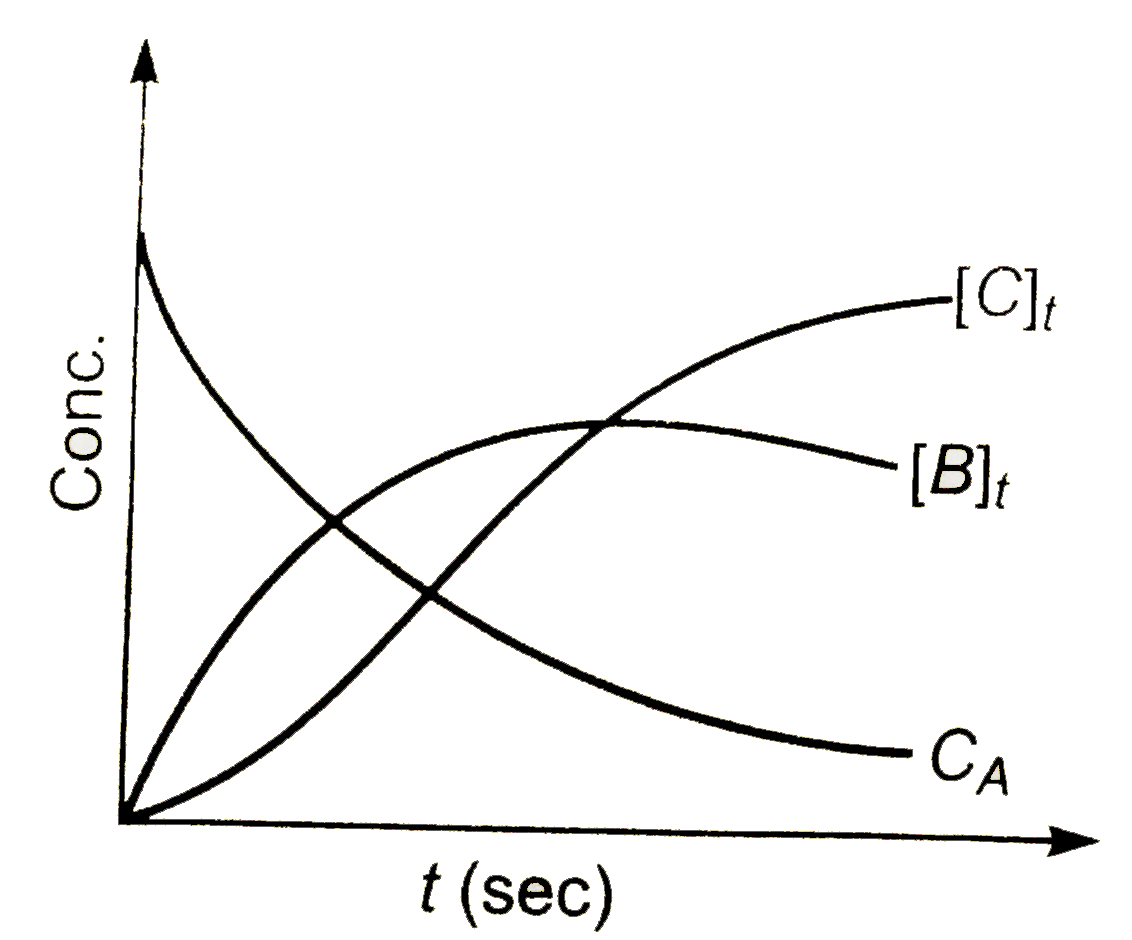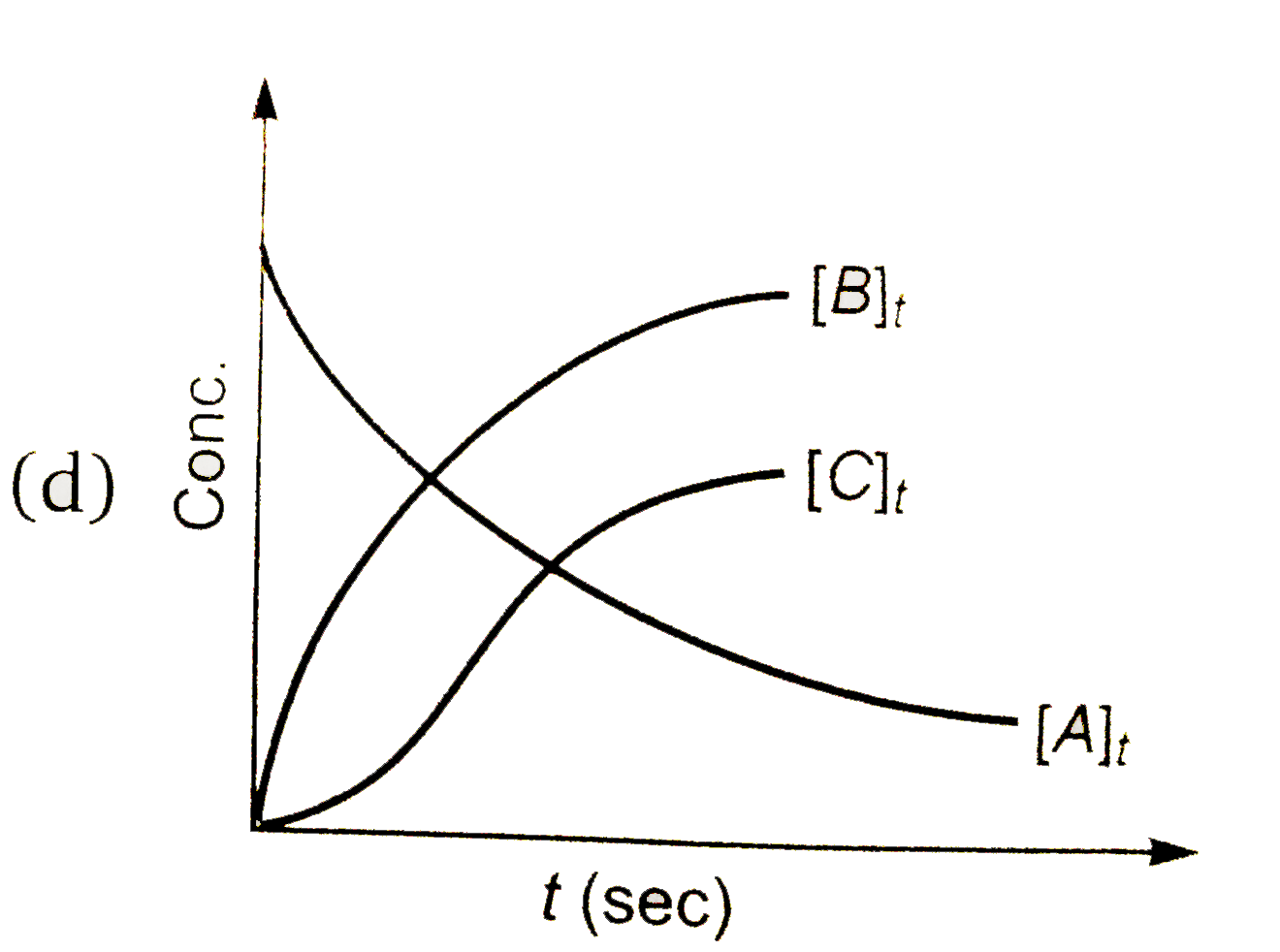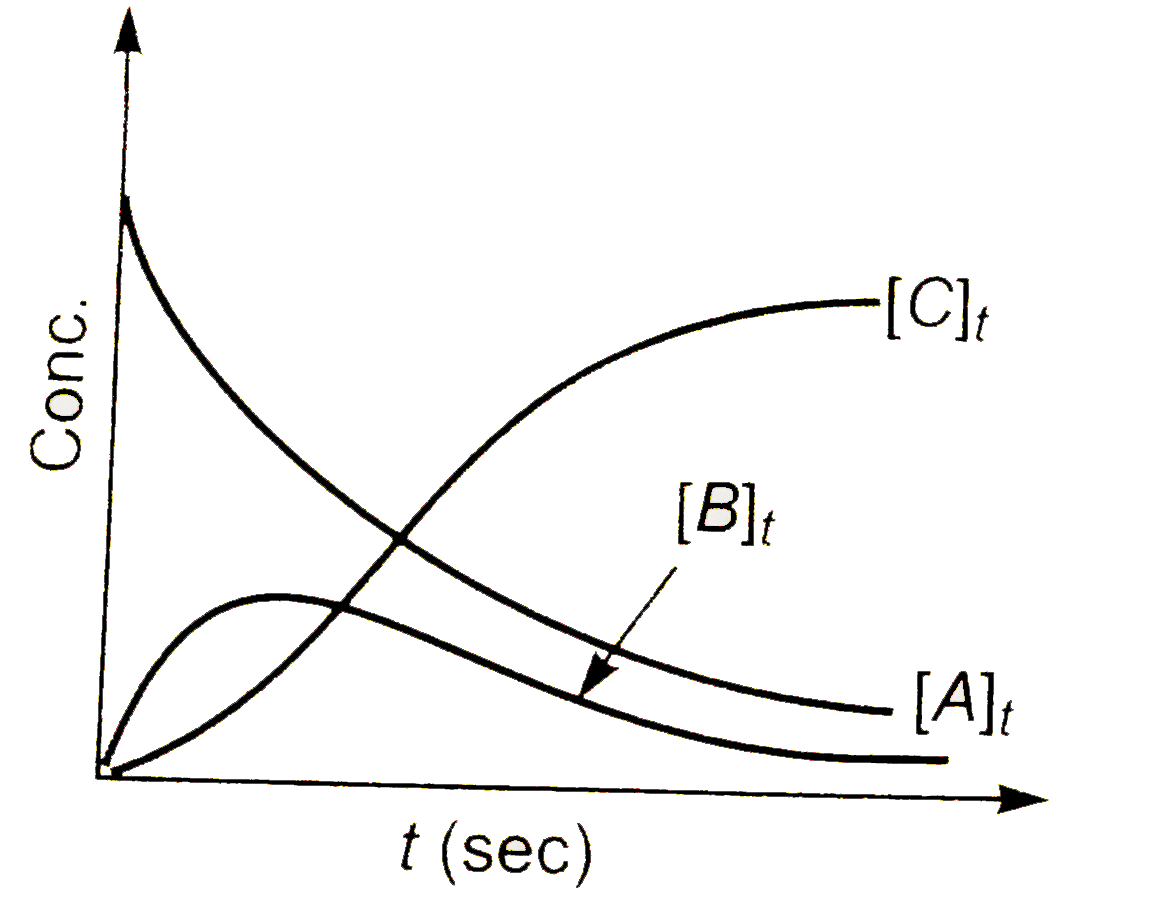Two consecutive irreversible first order reactions can be represented by
Ak1−−→Bk2−−→C
The rate equation for A is readily interated to obtain
[A]t=[A]0.e−k1t , and [B]t=k1[A]0k2−k1[e−k1(t)−e−k2(t)]
When k1=1s−1 and k2=500s−1 , select most appropriate graph
a) =[A](0).e^(-k(1^(t))) , and [B](t)=(k(1)[A](0))/(k(2)-k(1))[e^(-k(1)(t))-e^(-k(2)(t))] When k(1)=1s^(-1) and k(2)=500s^(-1) , select most appropriate graph
a)
b)
c)
d)](https://d10lpgp6xz60nq.cloudfront.net/physics_images/NRA_PHY_CHM_JMA_C07_E01_187_O01.png) b)
b) 
c)  d)
d)  Solution in Punjabi
Solution in Punjabi




The correct Answer is:B
Step by step video & image solution for Two consecutive irreversible first order reactions can be represented by Aoverset(k_(1))(rarr)Boverset(k_(2))(rarr)C The rate equation for A is readily interated to obtain [A]_(t)=[A]_(0).e^(-k_(1^(t))) , and [B]_(t)=(k_(1)[A]_(0))/(k_(2)-k_(1))[e^(-k_(1)(t))-e^(-k_(2)(t))] When k_(1)=1s^(-1) and k_(2)=500s^(-1) , select most appropriate graph a) b) c) d) by Chemistry experts to help you in doubts & scoring excellent marks in Class 12 exams.
Topper's Solved these Questions
- BOOK - NARENDRA AWASTHICHAPTER - CHEMICAL KINETIC & NUCLEAR CHEMISTRYEXERCISE - Level 1 (Q.3 To Q.32)1videos
CHEMICAL KINETIC & NUCLEAR CHEMISTRY
- BOOK - NARENDRA AWASTHICHAPTER - CHEMICAL KINETIC & NUCLEAR CHEMISTRYEXERCISE - Level 1 (Q.33 To Q.62)2videos
CHEMICAL KINETIC & NUCLEAR CHEMISTRY
- BOOK - NARENDRA AWASTHICHAPTER - SURFACE CHEMISTRYEXERCISE - Level -21videos
SURFACE CHEMISTRY
Similar Questions
The following data pertain to reaction between A and B
S.No[A][B]RatemolL−1molL−1molL−1sec−1I1×10−22×10−22×10−4II2×10−22×10−24×10−4III2×10−24×10−28×10−4
Which of the following interference(s) can be drawn from the above data
(a) Rate constatnt of the reaction 10−4
(b) Rate law of reaction is k[A][B]
(c ) Rate of reaction increases four times on doubling the concentration of both the reactant Select the correct answer codes:
a) a,b and C
b) a and b
c) b and c
d) c alone02:21View Solutioncolumn Icolumn IIP.Zero order reaction1.t1/2α1[A]0Q.First order reaction2.t100%=[A]0/kR.second order reactions3.Involves at least two reactantsS.Pseudo unimolecular reaction4.[A]=[A]0e−kt
06:38View Solutionfor the graph below, select correct order of temperture ?
 02:12View Solution
02:12View SolutionFor a gaseous reaction, following data is given:
A→B,k1=1015e−2000/T
C→D,k2=1014e−1000/T
The temperature at which k1=k2 is04:17View SolutionFor the consecutive unimolecular-type first-order reaction Ak1−−→Rk2−−→S, the concentration of component R, CR at any time t is given by -
CR=COAK1[e−k1t(k2−k1)+e−k2t(k1−k2)]
if CA=CAO,CR=CRO=0 at t=0
The time at which the maximum concentration of R occurs is -01:55View SolutionThe rate constant k1 and k2 for two different reactions are 1016e−2000/T and 1015e−1000/T, respectively. The temperature at which k1=k2 is
View SolutionTwo consecutive irreversible fierst order reactions can be represented by Aoverset(k_(1))(rarr)Boverset(k_(2))(rarr)C The rate equation for A is readily interated to obtain [A]_(t)=[A]_(0).e^(-k_(1^(t))) , and [B]_(t)=(k_(1)[A]_(0))/(k_(2)-k_(1))[e^(-k_(1)^(t))-e^(-k_(2)^(t))] At what time will B be present in maximum concentration ?
03:28View SolutionTwo consecutive irreversible fierst order reactions can be represented by
Ak1−−→Bk2−−→C
The rate equation for A is readily interated to obtain
[A]t=[A]0.e−k1t , and [B]t=k1[A]0k2−k1[e−kt1−e−kt2]
When k1=1s−1 and k2=500s−1 , select most appropriate graph02:12View SolutionTwo consecutive irreversible fierst order reactions can be represented by Aoverset(k_(1))(rarr)Boverset(k_(2))(rarr)C The rate equation for A is readily interated to obtain [A]_(t)=[A]_(0).e^(-k_(1^(t))) , and [B]_(t)=(k_(1)[A]_(0))/(k_(2)-k_(1))[e^(-k_(1)^(t))-e^(-k_(2)^(t))] If k_(1) and k_(2) both are almost same then which graph is most suitable ?
02:15View SolutionTwo consecutive irreversible fierst order reactions can be represented by
Ak1−−→Bk2−−→C
The rate equation for A is readily interated to obtain
[A]t=[A]0.e−k1t , and [B]t=k1[A]0k2−k1[e−kt1−e−kt2]
Select the corret statement for given reaction:02:12View SolutionThe rate constants k_(1) and k_(2) for two different reactions are 10^(16) * e^(-2000//T) and 10^(15) * e^(-1000//T) , respectively . The temperature at which k_(1) = k_(2) is
03:08View SolutionThe rate constants k1 and k2 for two different reactions are 1025e−4000/T and 1025e−1000/T, respectively. The temperature at which k2=k2 is
03:10View SolutionThe rate constant k1 and k2 for two different reactions are 1016e−2000/T and 1015e−1000/T, respectively. The temperature at which k1=k2 is
07:03View Solution{:(A rarr B, k_(A)=10^(15)e^(-2000//T),),(C rarr D, k_(C )=10^(14)e^(-1000//T)):} Temperature T K at which (k_(A)=k_(C )) is :
02:42View SolutionFor the two gaseous reactions, following data are given A→B,k1=1010e−20,000/T,C→D,k2=1012e−24,606/T the temperature at which k1 becomes equal to k2 is :
03:26View Solutionदो विभिन्न अभिक्रियाओं के लिए वेग स्थिरांक k1 तथा k2 के मान क्रमश: 1016.e−2000/T तथा 1015⋅e−1000/T हैं। जिस ताप पर k1=k2 होता है, वह है।
04:45View Solution

